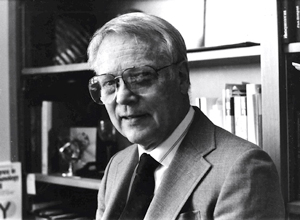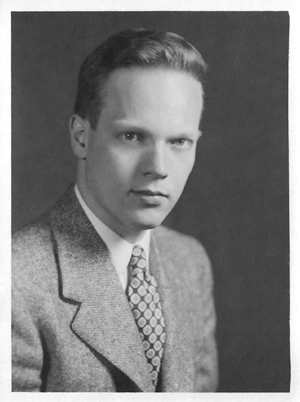Back to 60th Anniversary Reflections.
Dr. John L. Fahey describes CC's opening day

Dr. John L. Fahey is an immunologist, researcher and educator. He discovered Immunoglobulin D and delineated and characterized the important classes and subclasses of human immunoglobulins while at NCI in the late 1950's and 1960's. Dr. Fahey shared his firsthand memories of the dedication of the NIH Clinical Center with CC News in a phone interview conducted on July 2, 2013.
You were present at the Clinical Center's Dedication Ceremony in July 1953. Can you describe it?
The day was hot and sunny. We were standing on the Clinical Center's north side for the dedication, where the Ambulatory Care Research Facility is now. There was a group of dignitaries, including Department of Health, Education and Welfare Secretary Olvita Culp Hobby, who spoke. The speeches promised that this site would contribute to future improvements in medicine. This turned out to be true. But no one there could have foreseen the incredible advances of the next 60 years.
Can you also describe the emotions of the attendees that day?
The new Clinical Research staff (designated as clinical associates) were impressed with the size of the Clinical Center, a new, large brick building. We wanted to see inside. How would it be different from the academic medical institutions we had been in previously? Clearly, the intent was to provide great resources for medical research. We were not familiar with the Public Health Service. How would this work out? What exactly would be expected of us?
We weren't invited into the building the first day. We came back the next day. Construction workers were still finishing the building's interior. Only one floor was ready to receive patients. The first patients didn't arrive until several days later.
Why was the opening of the Clinical Center important?
I first heard about plans for a new clinical research center in the spring of 1950, in a public health class at Harvard Medical School. Dr. Jack Masur spoke to us about it. I still have my notes from his speech, because I thought that this was a great career opportunity.
At the time, combining clinical and laboratory research activities was not a common goal of medical students. It was an extremely rare program, but it was a good way to get started in medical research.
The Clinical Center's opening was a big advance for clinical research. Previously, scientists conducting clinical research at the Rockefeller Institute for Medical Research in New York City could not do studies in July and August because there was no air conditioning. Since the Clinical Center was air conditioned, we could work in the summer. We were all aware of the Clinical Center's potential. No building on that scale had ever been devoted to medical research. The clinical associates who came were bright and enthusiastic.
There were start-up problems. For instance, only nurses worked overnight: the doctors went home. Within two weeks of opening, it became clear that doctors were needed to staff the building 24 hours a day. There were patients with advanced cancer and heart diseases who needed that coverage. On the Clinical Center's top floor, the hospital staff placed beds into spare rooms for the on-call doctors. Dr. Roy Hertz had a small unit at George Washington University Hospital in D.C. to study breast cancer and endocrine treatment. He moved his patients and staff to the Clinical Center within three months of the Clinical Center's opening. Several other Institutes had created provisional research units at the Public Health Service Hospital in Baltimore.
You arrived at NIH in July 1953 as a commissioned officer in the PHS. What did you do on your first tour of duty?

It took several years to build clinical referral networks by which patients came to the NIH with suitable diseases and stages of disease for participation in specific studies. Thus, in the first two years, clinical care did not take a lot of my time. I used the time to build protein and metabolic laboratories that focused on Immunology research.
How long were you at the NIH? What did you do after that?
I left the NIH in 1971, after 18 years there. I joined the University of California at Los Angeles School of Medicine. At UCLA, I wanted to create something similar to the Clinical Center. Grants from the NIAID and the NCI fostered the establishment of a Center for Interdisciplinary Research in Immunology and Disease which supported the faculty group at UCLA that discovered AIDS and notified the NIH of the existence of that new disease in 1981. Michael Gottlieb was in that group.
What was it like in those early days? What was the atmosphere, and how was it different then than it is now?
The administrative structure and clinical research procedures were being established in the first years at the Clinical Center. Most clinical associates stayed for two years. They came from institutions in Boston, New York, Philadelphia and Baltimore, and readily built friendships. At that time there was a lot of turnover. Now, several people have worked at the Clinical Center for 50 years. And research associates come from all over the world.
Why is the work of NIH important?
The CC was unique in the 1950s and 60s, but now clinical research facilities have been developed throughout the United States. The NIH's extramural grant programs are very important. In the past 50 years, the NIH has sponsored a great deal of research both in the CC and in academic institutions. The CC is also working with industry to expedite the clinical applications of research advances. The Fogerty Center has facilitated international interactions. People in medical research all over the world want to collaborate with the NIH and American biomedical science.
What do you think more Americans need to know about the work that goes on in the CC?
Americans need to realize that research is conducted in many ways, in the CC and elsewhere. Examples of how basic research has allowed clinical advances to be made are appreciated. An important concept that the NIH Clinical Center emphasized from the beginning is now called "translational research," In which laboratory studies are used to address clinical problems. That's why the Clinical Center was built to house both patient facilities and research laboratories. Very significant and clinically relevant work was—and still is—taking place there.
